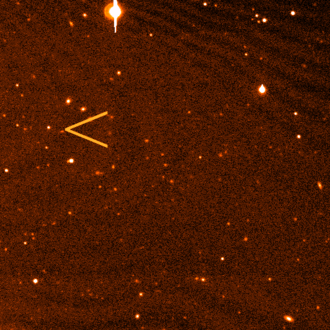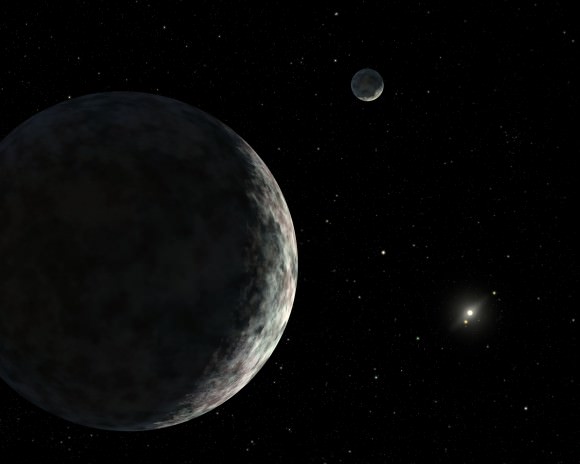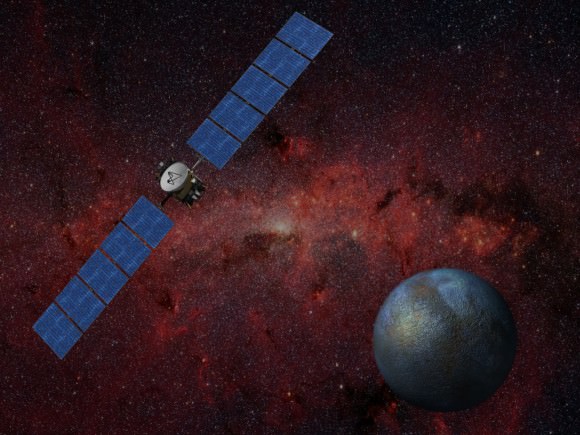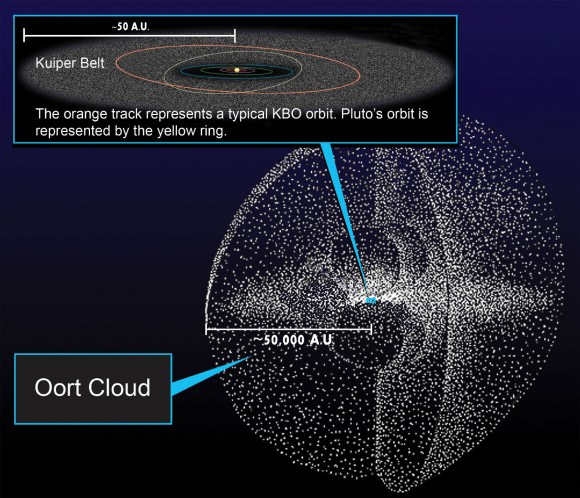The self-professed “Pluto Killer” is at it again. Dr. Michael Brown is now reminiscing about the good old days when one could scour through sky survey data and discover big bright objects in the Kuiper Belt. In his latest research paper, Brown and his team have concluded that those days are over.
Ten years ago, Brown discovered what is now known as the biggest Kuiper Belt object – Eris. Brown’s team found others that rivaled Pluto in size and altogether, these discoveries led to the demotion of Pluto to dwarf planet. Now, using yet another sky survey data set but with new computer software, Brown says that its time to move on.

Like the famous Bugs Bunny cartoon, its no longer Rabbit Season or Duck Season and as Bugs exclaims to Elmer Fudd, there is no more bullets. Analyzing seven years worth of data, Brown and his team has concluded we are fresh out of Pluto or Charon-sized objects to be discovered in the Kuiper Belt. But for Dr. Brown, perhaps it now might be Oort Cloud season.
His latest paper, A Serendipitous All Sky Survey For Bright Objects In The Outer Solar System, in pre-print, describes the completion of analysis of two past sky surveys covering the northern and southern hemisphere down to 20 degrees in Galactic latitude. Using revised computer software, his team scoured through the data sets from the Catalina Sky Survey (CSS) and the Siding Spring Survey (SSS). The surveys are called “fast cadence surveys” and they primarily search for asteroids near Earth and out to the asteroid belt. Instead Brown’s team used the data to look at image frames spaced days and months apart.
Update: In a Twitter communique, Dr. Brown stated, “I would say we’re out of BRIGHT ones, not big ones. Could be big ones lurking far away!” His latest work involved a southern sky survey (SSS) to about magnitude 19 and the northern survey (CSS) to 21. Low albedo (dark) and more distant KBOs might be lurking beyond the detectability of these surveys that are in the range of Charon to Pluto in size.

Objects at Kuiper Belt distances move very slowly. For example, Pluto orbits the Sun at about 17,000 km/hr (11,000 mph), taking 250 years to complete one orbit. These are speeds that are insufficient to maintain ven a low-Earth orbit. Comparing two image frames spaced just hours apart will find nearby asteroids moving relative to the star fields but not Kuiper belt objects. So using image frames spaced days, weeks or even months apart, they searched again. Their conclusion is that all the big Kuiper belt objects have been found.
The only possibility of finding another large KBO lies in a search of the galactic plane which is difficult due to the density of Milky Way’s stars in the field of view. The vast number of small bodies in the Kuiper belt and Oort Cloud lends itself readily to statistical analysis. Brown states that there is a 32% chance of finding another Pluto-sized object hiding among the stars of the Milky Way.

Dr. Brown also released a blog story in celebration of the discovery of the largest of the Kuiper Belt objects, Eris, ten years ago last week. Ten years of Eris, reminisces about the great slew of small body discoveries by Dr. Brown, Dr. Chad Trujillo of Gemini Observatory and Dr. David Rabinowitz of Yale Observatory.
Brown encourages others to take up this final search right in the galactic plane but apparently his own intentions are to move on. What remains to be seen — that is, to be discovered — are hundreds of large “small” bodies residing in the much larger region of the Oort Cloud. These objects are distributed more uniformly throughout the whole spherical region that the Cloud defines around the Sun.
Furthermore, Dr. Brown maintains that there is a good likelihood that a Mars or Earth-sized object exists in the Oort Cloud.
Small bodies within our Solar System along with exo-planets are perhaps the hottest topics and focuses of study in Planetary Science at the moment. Many graduate students and seasoned researchers alike are gravitating to their study. There are certainly many smaller Kuiper belt objects remaining to be found but more importantly, a better understanding of their makeup and origin are yet to be revealed.

Presently, the Dawn spacecraft is making final approach to the dwarf planet Ceres in the Asteroid belt. The first close up images of Ceres are only a few days away as Dawn is now just a couple of 100 thousand miles away approaching at a modest speed. And much farther from our home planet, scientists led by Dr. Alan Stern of SWRI are on final approach to the dwarf planet Pluto with their space probe, New Horizons. The Pluto system is now touted as a binary dwarf planet. Pluto and its moon Charon orbit a common point (barycenter) in space that lies between Pluto and Charon.
So Dr. Brown and team exits stage left. No more dwarf planets – at least not soon and not in the Kuiper belt. Will that upstage what is being called the year of the Dwarf Planet?
But next up for close inspection for the first time are Ceres, Pluto and Charon. It should be a great year.

References:
A Serendipitous All Sky Survey For Bright Objects In The Outer Solar System
2015, NASA’s Year of the Dwarf Planet, Universe Today
What is the Kuiper Belt?, Universe Today


My suspicion is that the biggest thing out there is bigger than Mars, but smaller than Venus.
Dr. Brown gave a lecture in January 2011 at Foothill College titled “How I Killed Pluto and Why it Had it Coming.” I highly recommend it. It is available free to download or stream as a podcast, part of The Silicon Valley Astronomy Lectures Podcast. Available on iTunes and, I’m sure, on other podcatchers.
Ok, thanks! On this page of Astronomical Society of the Pacific: https://astrosociety.org/edu/podcast/index.html — a whos-who of astro researchers also in the archive.
He’s a fool in that respect. Yeah right, now everyone knows exactly what is meant when one is talking about a planet. Mercury and Jupiter are almost identical, but Titan, Ceres and Pluto are totally different objects, it would be confusing to include them.
And did you know that not one single exoplanet has been found!? It has not been established that any single candidate has cleared its path, they might be exodwarfplanets. A giant hot Jupiter might be a “dwarf” according to the new well thought through definitions of the IAU. Btw, has Neptune cleared Pluto, is not Neptune a planet? Everything is crystal clear now. 400 years ago Earth was not a planet. There were only seven classical planets, including the Moon and the Sun, each day of the week has the name of a planet. The IAU does not understand that the concept “planet” is a cultural concept, not a metric definition. That’s why they made such a fool out of themselves. They have no say about what is a planet and what is not a planet. The culture decides that.
Oh dear, some anonymous random person on the Internet says the IAU are fools. I guess they should just disband then.
As for “culture”, It did not discover Pluto and cannot claim ownership. If we let “culture” dictate matters of science, we would still be geocentrists.
Oh dear, some random idiot on the internet refuses to use his own mind to instead give up to authority. Whatever the IAU says makes sense, for sure… Don’t mind actually dealing with the real problems which I have carefully described for you. You don’t need to mention them in your reply. And you didn’t.
Science is not dictated by culture. But how long a road is, what is a planet, is not a scientific issue, it is a cultural issue. When a congregation of any kind tries to officially change the meaning of a word, it can only fail. And it has. IAU has just caused mass media to ridicule what astronomers do. The whole Pluto/planet definition business was a huge failure and a burden to astronomy and all astronomers.
It begs the question what else they are doing wrong:
“-Why waste billions of tax dollars on stuff that this bunch of fools want to do, they cannot even define what a planet is, although they are standing on one, and they are supposed to be astronomers?”
Instead of killing Pluto they should have added all the (almost true) spheres that are not Moons and Orbit the Sun as Planets because that’s what they are …Amen
Just a note – On January 2 of this year I updated that first “largest small bodies in the Kuiper belt” image for my Dwarf Planets page using the latest data from Mike Brown at the time. See: http://calgary.rasc.ca/dwarfplanets.htm
Larry McNish, RASC Calgary Centre.
With a thanks to Larry, the main figure is updated. Ocean’s 12 has nothing on these 3 astronomers – the big heist – 9 of 10 biggest KBOs.
Compare http://phys.org/news/2015-01-trans-neptunian-planets-solar.html ?
Different frame of thought – both could be true or one is hiding from the other search….